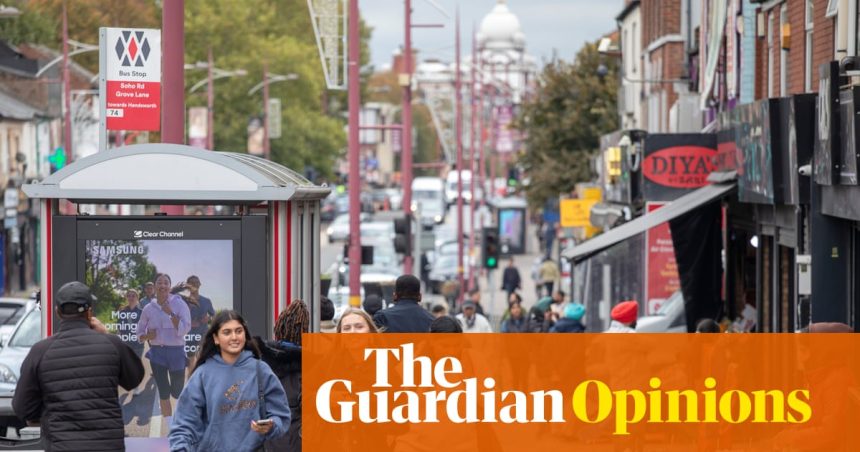“Handsworth wakes / But Handsworth never sleeps … With deep roots rooted everywhere / All of us who know this place / Can claim it as our private space … We’re one people and Handsworth proud … This is a place for everyone.”
The late poet Benjamin Zephaniah was a proud son of Handsworth, and like many of us who grew up there, he understood its complexities and loved its vibrancy. Zephaniah died in 2023 but he would have had much to say about shadow justice secretary Robert Jenrick’s recent comments about the diverse inner-city Birmingham ward.
Jenrick complained that he “didn’t see another white face” on his visit there, saying the area was “as close as I’ve come to a slum in this country”. After highlighting the lack of white people, Jenrick claimed it was not about “the colour of your skin or your faith”, but that he wanted people to “be living alongside each other”.
Waking up to Jenrick’s distorted comments as a British-Asian daughter of immigrant parents, I immediately felt like fodder in this latest salvo of our culture war, swept into “otherness” without a pause for thought about what those words would mean for millions of black, Asian and minority ethnic British people like me.
My relationship with Handsworth is complicated. I was born and lived there until my late teens and my mother and close family members still live in the area. My parents both worked in the same cotton factory owned by a Gujarati family near our home, and I would sometimes sneak in for a visit; loving the whirr of the machines and watching my dad operating the big iron presses as my mum sat sewing uniforms with all the other machinists.
Watching everyone at work would instil in me the strong work ethic that I still possess to this day. There were games of cricket in our cul-de-sac with neighbours of Bangladeshi, Indian and Pakistani heritage as well as those who were white. Many weekends and afternoons were spent on Soho Road, at the time a thriving artery, where kitchens simmered with samosas and Indian sweetmeats, and brides would buy their intricately embroidered wedding lehengas in the numerous fabric shops, while other residents headed to temples, mosques and churches located on the streets nearby. It was definitely, as Zephaniah wrote in his poem named after that road, a place for everyone.
Handsworth is now and was then a melting pot of different ethnicities, including white British. Of the 12,000 people who live in Handsworth, 91.3% identify as BAME and according to Birmingham city council, the ethnicity of Handsworth is 25% Pakistani, 23% Indian, 10% Bangladeshi, 16% Black African or Black Caribbean, 10% mixed or other ethnic group and 9% white. In overall terms, the health of residents in Handsworth is worse than the average for England, and it is among the more deprived wards in the city, with employment rates much lower than Birmingham’s average. I have previously written about the complex relationship between some of the most deprived areas of Birmingham, integration and immigration, including during our Voices and votes series and the Brexit referendum.
Handsworth, as one of those areas with high deprivation, is not a place without its issues. In recent years, there have been growing reports of prostitution, antisocial behaviour and alcohol and drug abuse. Many different communities do live side by side, but even during my childhood there were some factions that did not mix, though nothing on a level that would justify Jenrick’s allegation of a community living separate, “parallel” lives.
Then there are the bins. Bin workers in Birmingham have been striking since January and walked out indefinitely in March in a dispute over job and pay cuts. Piles of black bags in the streets and overflowing wheelie bins have led to an influx of rats in some parts of the city. Yet Jenrick described this as a “litter” problem, comparing the area to a “slum”, and seeming to imply that the issue was somehow linked to a lack of integration.
Just a few weeks ago, I spoke to frustrated family members of the postcode bin lottery. Those who live in the slightly more salubrious area of Handsworth Wood were having their bins collected, but those just across the border in Handsworth were left with rubbish piling up outside their homes, including my mother – who is one of the most house-proud people you’re ever likely to meet.
after newsletter promotion
Jenrick ignored the years of serious neglect and austerity behind the area’s issues. But really, this wasn’t about Handsworth at all: it was a cynical attempt to out-Reform Reform, to stoke division and use the colour of people’s skin to make his point. The danger does not lie in places like Handsworth, but in Jenrick’s words.
Jenrick said that in Handsworth he saw a country that he didn’t want to live in. In August, my mother had major heart surgery, and while I sat next to her hospital bed, visitor upon visitor walked through the doors; some family, but others friends from her local community. At that crucial time, her community had gathered around her, and as a child, I remember this happening time and time again. That’s the kind of country I want to live in.

Leave a Reply